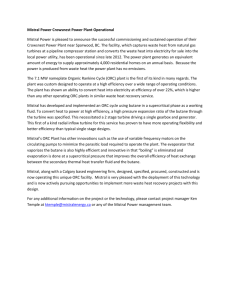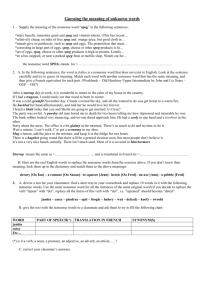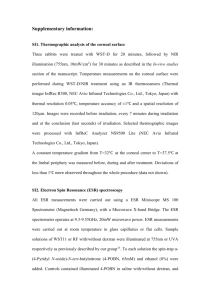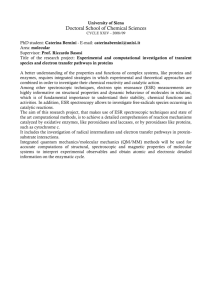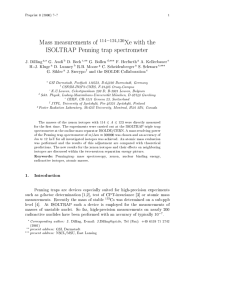Document
advertisement
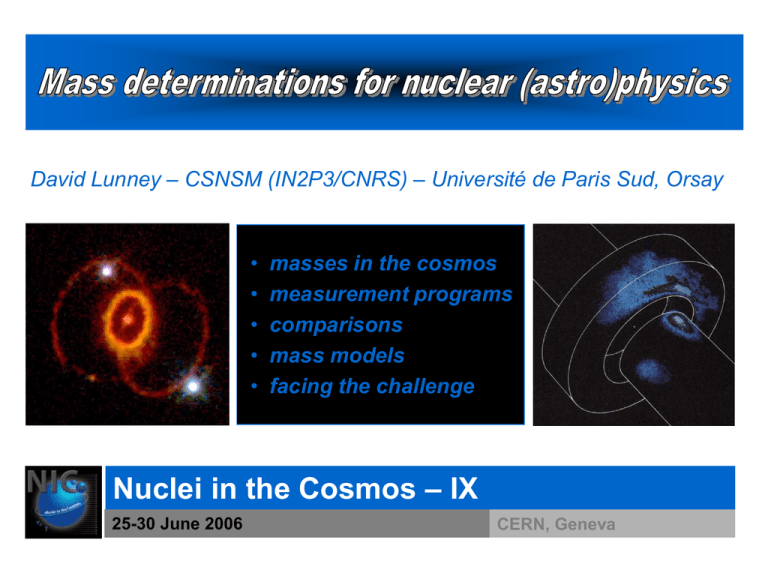
David Lunney – CSNSM (IN2P3/CNRS) – Université de Paris Sud, Orsay • • • • • masses in the cosmos measurement programs comparisons mass models facing the challenge Nuclei in the Cosmos – IX 25-30 June 2006 CERN, Geneva Some introductory remarks on history High resolution mass spectrographs F.W.Aston (~1920‘s): 212 isotopes discovered Packing fraction E = mc2 How the sun shines,” J. Bahcall http://nobelprize.org/physics/ A. Eddington (~1920) Stellar combustion Motivation from “fundamental” physics metrology: the kilogram: 28Si atomic mass standard and other fundamental constants (what if they vary with time?!) nuclear structure from the mass surface nuclear structure from the mass surface stable isotopes s-process path r-process path b - decay path known masses Stellar Nucleosynthesis (A 200) p-isotope s-isotope r-isotope At Po Bi Pb Tl Hg Au Pt Ir Os Re W Ta Hf Lu Yb Tm Er b decay one / two b -delayed neutron decay neutron number 126 Techniques Direct (energy) (mass spectrometry) time of flight: TOF = (m/q) (L/Br ) FIFS (MeV) gas cell RFQ decays: AB+a Qa = MB- MA cyclotron frequency: fc = qB/m ISOL (keV) ‘the best of both worlds’ better precision reactions: A(a,b)B Q = MA+ Ma- Mb- MB PRODUCTION SCHEME better sensitivity Indirect UW-PTMS FSUTRAP (MIT) SPEG CSS2 (GANIL) ISOLTRAP (CERN) MISTRAL (CERN) ESR-FRS (GSI) mass measurement programs at GANIL CSS1 SPEG time-of-flight + magnetic rigidity m = q Br T / L Y Z Z X Y X SPEG Resolving power: 104 extremely sensitive H. Savajols et al., EPJ A 25 (2005) 23 and B. Jurado et al., submitted (2006) mass measurement programs at GANIL CSS2 time-of-flight: phase difference with acceleration (longer flight path) M. Chartier et al., J. Phy. G 31 (2005) S1771 CSS1 CSS2 mass measurement programs at GANIL CIME (SPIRAL) time-of-flight: variable RF acceleration (longer flight path) M.-B. Gomes Hornillos et al., J. Phy. G 31 (2005) S1869 mass measurement programs at GSI Experimental Storage Ring: D(m/q)/(m/q) = Dv/v (gt2 - g2) - Df/f gt2 Schottky Mode very precise but cooling slow Isochronous Mode very fast but not as precise Yu. Litvinov, Ph.D. (2003): ~ 600 species in the ring 466 masses measured (117 calibration masses) 139 masses from links 200 improved masses 75 new mass values Yu. Novikov et al., Nucl Phys A (2002) SMS 2002 E. Kaza, Ph.D (2004) Yu. Litvinov et al., (2005) IMS J. Stadlmann (Ph.D) and Phys. Lett. B (2004) IMS 2002 M. Matos, Ph.D (2004) see talk of F. Bosch Booster 1.4 GeV PS Linac2 50 MeV ISOLTRAP 10 m REX-ISOLDE GPS HRS ISOLDE CERN, Geneva MISTRAL Quadrupole Doublet ISOLDE Beam Reference Source 25120 25100 Alburger 78 * MISTRAL 2005 1m Mass Excess (keV) MISTRAL COLETTE Paul trap 25080 25060 25040 Detector 12Be (T1/2 = 21 ms) 25020 * D.E. Alburger et al. Phys. Rev. C 18, 2727 (1978) The mass spectrometer ISOLTRAP see talk of A. Herlert hyperbolic Penning trap: precision mass measurement cylindrical Penning trap: isobar separation & cooling 1m 2 cm 20 cm low energy bunches continuous 60 keV ISOLDE beam Gas-filled RF-Paul trap: universal beam collector TITAN (TRIUMF) (RIKENRING) CPT (ANL) LEBIT (NSCL) JYFLTRAP SMILETRAP (MSI) ISOLTRAP (CERN) SHIPTRAP (GSI) MATS (FAIR) MAFFTRAP or “what ISOLTRAP hath wrought” Canadian Penning Trap (CPT) facility at ANL - 46Ti: Savard et al., PRL (2005) (not available from ISOLDE) See poster here. 46V beam JYFLTRAP at the Jyväskylä IGISOL trap cooler cooler mass separator ISOLDE elements IGISOL elements See poster of A. Jokinen ion guide SHIPTRAP facility at GSI ISOL facility for transuranium nuclides 92Mo (58Ni,xpyn) 147Ho new masses for 147Ho, 147,148Er (10-6) (M. Block et al., ENAM04) see poster here Low Energy Beam & Ion Trap (LEBIT) facility at NSCL/MSU G. Bollen et al., PRL 96 (2006) http://www.nscl.gov/lebit TOF stop TOF start K500 S800 ha r e f s tran ll Br meas. 10m K1200 A1900 dE [a.u.] 1000 86Kr primary beam Ge Ga Zn Cu 800 M. Matoš (CGS-12, Notre Dame) AIP Conf. Proc. 819 (2006) 164 See poster of A. Estrade Ni Co Fe Mn Cr V Ti Sr Ca K Ar Cl S 600 400 200 20 30 40 DTOF[ns] 50 60 70 postaccelerator magnet target cyclotron 10 -4 relative uncertainty SPEG 10 10 -5 ESR SMS 1995 -6 ESR IMS ESR SMS 1997 CSS2 MISTRAL 10 -7 ISOLTRAP 10 -8 10 -9 0 1 2 3 4 relative isobaric distance from stability Reviews of Modern Physics, 75 (2003) 1021 relative uncertainty 10 -4 10 -5 10 -6 CSS2 ESR IMS SPEG ESR SMS MISTRAL 10 -7 10 -8 10 -9 CPT ISOLTRAP 0 1 2 3 4 relative isobaric distance from stability ENAM04 Proc., Eur. Phys. J. A, 25 (2005) 3 relative uncertainty 10 -4 10 -5 10 -6 (CSS2) (ESR IMS) ORNL MISTRAL (ESR SMS) 10 SPEG JYFLTRAP -7 SHIPTRAP 10 -8 10 -9 ISOLTRAP LEBIT CPT 0 1 2 3 4 relative isobaric distance from stability Proc. Nuclei in the Cosmos IX, PoS (2006) ? 10 Performance of the various methods -4 relative uncertainty SPEG 10 -5 10 -6 ESR IMS CSS2 JYFL COOL MISTRAL ESR SMS 10 -7 10 -8 10 -9 CPT ISOLTRAP 10 6 10 3 10 0 half life (seconds) See: Lunney, Pearson & Thibault, Rev. Mod. Phys. 75 (2003) 1021 10 -3 relative uncertainty 10 -4 10 -5 10 -6 neutron-rich proton-rich (ESR IMS) (CSS2) SPEG ORNL MISTRAL (ESR SMS) 10 -7 JYFLTRAP SHIPTRAP ISOLTRAP 10 -8 CPT LEBIT 10 -9 -20 -10 0 10 20 30 (left) neutron- (right) proton-separation energy (MeV) stable indirect 100 GANIL SPEG CSS2 80 GSI ESR-SMS ESR-IMS SHIPTRAP proton dripline (FRDM95) ISOLDE MISTRAL ISOLTRAP Z 60 neutron dripline (FRDM95) 40 Other Penning traps CPT (ANL) LEBIT (MSU) JYFLTRAP 20 0 0 50 100 N 150 MAFF facility at FRM-II trap Münich Accelerator for Fission Fragments funnel Bavarium n-rich nuclides D. Habs et al., ENAM 2004 (MAFF workshop 04/2005) trap TRIUMF Ion Trap (TITAN) facility EBIT Rapid charge breeding (2-30 ms) Wien filter m/q selection fc = qB/m Paul trap Cooling and Mass measurements Bunching (1-5ms) Penning trap Precision mass measurement (~ 10-100ms) ISAC beam • T1/2 ≈10 ms •m/m < 110-8 •Operational 2006 J. Dilling et al. ENAM04 Beyond the horizon Beyond the horizon FAIRTRAP (MATS) GSI ’s future Facility for Antiproton and Ion Research (FAIR) FAIR RINGS (ILIMA) stable nuclei nuclides with known masses G.Audi et al., Nucl. Phys. A729 (2003) 3 to be be measured measured with with FAIR the FRS-ESR to facility measured with FRS-ESR observed nuclei observed nuclei 82 r-process 126 50 82 28 50 20 8 28 20 8 stellar nucleosynthesis The atomic mass evaluation* Not a compilation ! S P Si Al 16 15 14 13 27Al (p,g) 28Si 28Si (3He,8Li) 23Al 28Si (4He,8He) 24Si 28Si (p,t) 26Si 28Si (p,n) 28P 28Si (d,p) 29Si 28Si (p,g) 29P 28Si (+,-) 28S 31P (p,a) 28Si and 28Si / 12C 10 11 12 13 14 15 16 * G. Audi and A.H. Wapstra, Nuclear Physics 1988, 1993, 1995, 2003 The Mass Evaluation . . . 28Si . . . . . . 28Si . . . . . . = 1 . . . least squares mass adjustment (1993) • • • • • 5520 experimental data (186 rejected) plus 601 estimated data 3652 equations; 3017 parameters 1920 ground state masses plus 730 recommed values Audi-Wapstra mass table A simplified overview of mass models physics input algebraic formulas (Garvey-Kelson; IMME) microscopic sculpturings of a macroscopic blob microscopic nucleon-nucleon interaction (FRDM) (RMF / HFB) ease of use now full HFB Extended Thomas-Fermi Strutinki Integral model macro: TF Skyrme approximation micro: Strutinski correction (folded Skyrme) 9 parameters good mass fit most nuclear properties HFBCS: HFB 1: HFB 2: HFB 3: HFB 4-7: HFB 8: HFB ... S. Goriely et al., At. Nuc. Data (2001) M. Samyn et al., Nucl. Physics (2002) S. Goriely et al., Phys. Rev. C (2002) M. Samyn et al., Nucl. Physics (2003) S. Goriely et al., Phys. Rev. C (2003) M. Samyn et al., Phys. Rev. C (2004) Fit to 1995 AME (1768 masses) 15+4 15+4 18+4 19+12 34+81 21+12 28 mass data parameters + other data parameters 0.8 local models 0.6 0.5 0.4 0.3 0.2 0.1 Chaos-limited mass prediction? Only 60% masses fit LZ JM G K NS KU TY DZ CS -1 HF B1 HF B2' FR D M TF -F R DM 0 HF B rms error (MeV) 0.7 mass model comparisons D. Lunney et al., ENAM 1995 (Arles) From: D. Lunney, “Nuclear masses: Experimental programs, theoretical models and astrophysical interest,” p. 296 Conclusions Mass Measurements higher performance; programs multiplying more data, better quality Mass Evaluation global benchmark (last judgement) Mass Models microscopic era; real need for data (diagnostic tool) “A false balance is abomination to the Lord: but a just weight is his delight.” — Proverbs 11.1 Lichtenberg: To find something new, must build something new. “The construction of the universe is certainly much easier to explain than that of a plant”. Kierkegaard: I must find a truth that is true for me.
